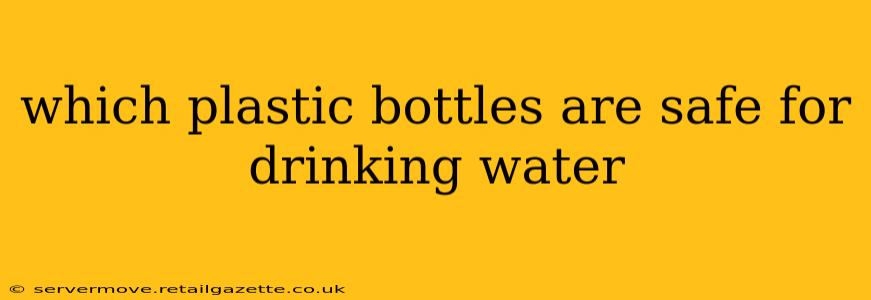Which Plastic Bottles Are Safe for Drinking Water? A Comprehensive Guide
Choosing the right plastic bottle for your drinking water is crucial for both your health and the environment. Not all plastics are created equal, and some can leach harmful chemicals into your water, especially when exposed to heat or sunlight. This guide will help you navigate the confusing world of plastic bottle safety.
The key to understanding plastic bottle safety lies in understanding the recycling codes. These codes, usually found on the bottom of the bottle, indicate the type of plastic used. However, the presence of a recycling symbol doesn't automatically mean a bottle is safe for drinking water.
Understanding Plastic Resin Identification Codes (RIC)
Several plastics are used to make water bottles, each with varying levels of safety for repeated use and water storage:
-
#1 PETE (Polyethylene Terephthalate): This is the most common plastic used for single-use water bottles. While generally considered safe for single use, repeated use or exposure to high temperatures can cause chemicals like antimony trioxide to leach into the water. It's best to avoid reusing PETE bottles.
-
#2 HDPE (High-Density Polyethylene): HDPE is generally considered safe for repeated use and is often used for milk jugs and cleaning products. It's more durable and less prone to leaching chemicals than PETE. HDPE bottles are a better choice for reusable water bottles.
-
#3 PVC (Polyvinyl Chloride): Avoid PVC plastics completely. They contain plasticizers (phthalates) that are linked to health problems and are not suitable for food or drink containers.
-
#4 LDPE (Low-Density Polyethylene): LDPE is flexible and used in squeezable bottles and plastic bags. While generally considered safe, it's not ideal for repeated water bottle use due to its less rigid nature.
-
#5 PP (Polypropylene): PP is also generally considered safe for repeated use and is often used for reusable water bottles and food containers. It's durable and heat-resistant, making it a good choice. PP is a safe and popular option for reusable water bottles.
-
#6 PS (Polystyrene): Polystyrene is commonly used for disposable cups and takeout containers. Avoid this type of plastic as it can leach styrene, a potentially harmful chemical, into your drinks.
-
#7 Other: This category encompasses a variety of plastics, and it's best to avoid bottles labeled with this code as the safety of the specific material isn't always clearly defined.
H2: What are the safest plastic bottles for drinking water?
The safest plastic bottles for drinking water are typically those made from HDPE (#2) or PP (#5). These plastics are less likely to leach harmful chemicals into your water when reused and are generally considered food-safe. Look for bottles explicitly labeled as BPA-free, although the presence of BPA is less of a concern in these materials than in PETE.
H2: Are reusable plastic water bottles better than single-use?
Yes, generally reusable plastic water bottles (made from HDPE or PP) are better than single-use plastic bottles (PETE) for the environment. Single-use plastics contribute significantly to plastic waste and pollution. Reusable bottles reduce your environmental impact, even considering the eventual disposal or recycling of the reusable bottle.
H2: How can I tell if my plastic water bottle is safe?
Look at the recycling code on the bottom of the bottle. If it's #2 HDPE or #5 PP, it's generally considered safe for repeated use. Always avoid #3 PVC, #6 PS, and #7 "Other." If the bottle is damaged, cracked, or smells unusual, it's best to discard it.
H2: Can I reuse plastic water bottles indefinitely?
Even with safe plastics like HDPE and PP, it's recommended to replace your reusable water bottles periodically. Over time, scratches and wear can make them more susceptible to leaching chemicals or harboring bacteria. Also, the plastic can degrade over time. A good rule of thumb is to replace them every 1-2 years, depending on usage and condition.
H2: What are the alternatives to plastic water bottles?
Several eco-friendly alternatives to plastic water bottles exist, including:
- Stainless steel water bottles: Durable, reusable, and don't leach chemicals.
- Glass water bottles: Also a safe and reusable option, although they are more fragile.
- Aluminum water bottles: A lightweight and durable option.
By understanding the different types of plastics used in water bottles and making informed choices, you can ensure you are drinking water from safe containers and minimizing your environmental impact. Remember to always check the recycling code and replace your bottles periodically to maintain safety and hygiene.
